Heat Exchanger Market by Type (Shell & Tube, Plate & Frame, Air Cooled), Material (Metal, Alloys, Brazing Clad Materials), End-Use Industry (Chemical, Energy, Hvacr, Food & Beverage, Power, Pulp & Paper), And Region - Global Forecast to 2029
Updated on : June 14, 2024
Heat Exchanger Market
The global heat exchanger market size is projected to reach USD 32.3 billion by 2029 from USD 23.0 billion in 2024, at a CAGR of 7.0% during the forecast period. The heat exchanger market is projected to grow significantly in the coming years. They are an essential part of systems where regulating heat is an important factor. Heat exchangers enable the efficient transfer of heat between fluids, facilitating the effective utilization of energy. The growth in this market is driven by various factors like increasing industrialization in emerging economies, rising energy efficiency regulations and stringent emission standards, growing demand for heat pumps in developed countries due to limitations on conventional heating systems like boilers, and rising demand for sustainable, low-energy consumption & cost-effective heat exchangers. These factors also drive the necessity for research in heat regulation field to find the best solution for sustainability and emission control.
Global Heat Exchanger Market Trend
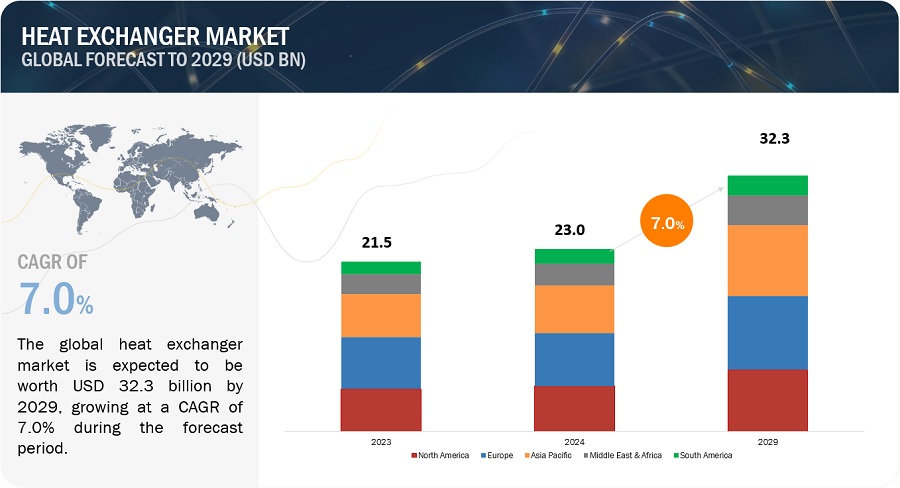
To know about the assumptions considered for the study, Request for Free Sample Report
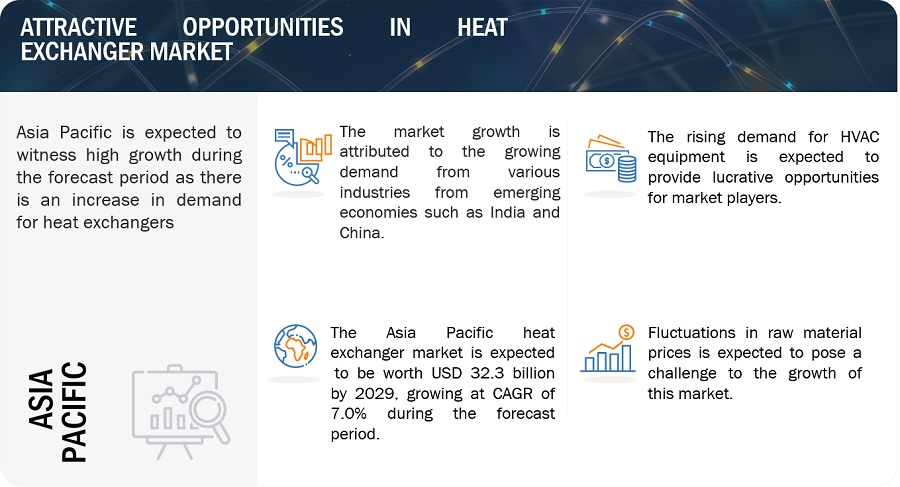
Heat Exchanger Market Dynamics
Driver: Growing demand for heat pumps in Europe
Heat exchangers used in heat pumps are essential for transferring heat through mediums such as air, water, or ground. The growing demand for heat pumps in Europe is driving the need for heat exchangers in in these systems. Heat pumps are commonly used in heating systems of residential, commercial, and industrial buildings to provide space heating, hot water, and cooling functionalities. Heat exchangers are used in heat pumps to enable the heat exchange between refrigerant and surrounding environment. Promoting these factors, the European Union are facilitating building renovation to enhance energy efficiency by the adoption of heat pumps. Countries like Poland, Czechia, Italy, France, and Germany are deploying regulations for systematic replacement of traditional heating systems with heat pumps. As older buildings undergo retrofitting with heat pump systems to lower carbon emissions and energy usage, the demand for heat exchangers correspondingly increases.
Restraint: Fluctuations in raw material prices
Heat exchanger manufacturers are always in risk of fluctuating raw material prices. Material like copper, aluminum, steel, and others are facing surge in prices due economic conditions, exchange rates, supply conditions, mining policies, and raw material processing. The Russia Ukraine war has also facilitated the increase in raw material and energy prices in the European region. This volatility in raw material prices impacts the profitability and operational efficiency of heat exchanger manufacturers. The surge in prices leads to unfavorable conditions for customers, which in turn may lead to delays and cancellation of large capital projects. This will directly impact the profitability and integrity of heat exchanger manufacturers. On the other hand, over supply due to reduced cost may impact the competitiveness and market position of heat exchanger manufacturers. These factors will influence the average selling price of heat exchangers in the market.
Opportunity: Growing aftermarket of heat exchangers
Heat exchangers play an important role in process industries, with its performance and durability directly impacting capital and operating expenses. Repair due to breakdown often incur significant costs. Therefore, regular maintenance of heat exchangers is essential for proper functioning of heat exchangers. The maintenance cost of heat exchangers is lower in comparison to equipment such as pumps, fans, and compressors. Regular maintenance of heat exchangers is essential for smooth running of operation, thus, maintaining system uptime, and prevention of sudden failures. Investing in regular maintenance for prevention of system breakdown is often more cost-effective than emergency repairs. Well-planned maintenance of heat exchangers enables companies to save energy and reduce operational costs by up to 30%. Proper maintenance is beneficial in the long run for prevention of pressure drops, which leads to reduced loads on pumps and other components. This will increase heat transfer rates and operational efficiency while maintaining lower energy consumption.
Challenges: Regulations concerning fluorinated gases
Various government agencies and regulatory bodies have highlighted the bad impact of emission of fluorinated gases (F-gases) into the environment. Participants in the supply chain of heat exchangers are often concerned about these regulations. European Union has implemented several regulations and amendments which directly aims at controlling emission of F-gases like hydrofluorocarbons (HFCs) to the environment. These amendments led to the adoption of two legislative acts by the EU. The MAC Directive is implemented for regulating air conditioning systems in small motor vehicles. Similarly, F-gas Regulation are concerned with systems employing the use of F-gases. The regulation lays out conditions for specific uses of fluorinated greenhouse gases and sets numerical thresholds for introducing hydrofluorocarbons into the market. In the US, The American Innovation and Manufacturing Act is a federal law in the United States that requires an 85% decrease in the production of fluorinated gases (F-gases) by 2036. These regulation poses a challenge to the manufacturers. The adaption rate to new regulations will play a crucial role in customer retention and market ranking.
Heat Exchanger Market Ecosystem
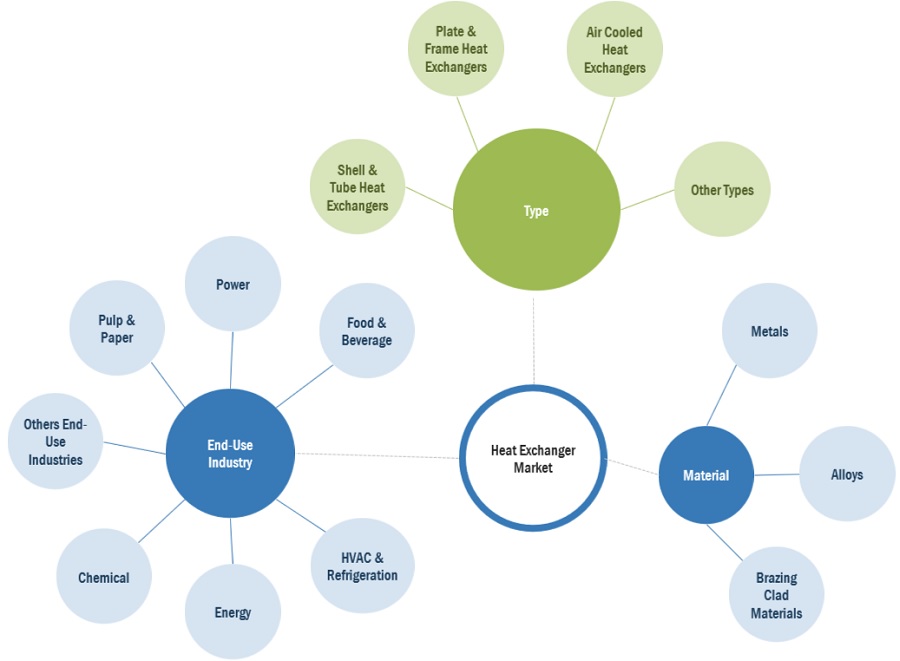
By material, metals are the fastest growing in heat exchanger market, in 2023.
Metals, alloys, and brazing clad materials are often used in the manufacturing of heat exchangers. Among these, metal heat exchangers drive the fastest growth in the heat exchanger market. Metals like, copper, aluminum, and stainless steel are excellent thermal conductors. This benefits in the efficient transfer of heat between fluids. This property is essential for rapid heat transfer, thus, making metals highly suitable for use in heat exchangers. Additionally, metal heat exchangers offer good mechanical strength and durability, making them suitable for environments where high temperatures, pressures, mechanical stresses are encountered. Reliability and longevity of heat exchangers is also maintained due to durability of metal heat exchangers. Metal heat exchangers are often cost-effective when compared to other materials.
By type, shell & tube is the largest in heat exchanger market, in 2023.
Shell & tube, plate & frame, and air cooled are some of the major type of heat exchangers. Among these, shell & tube heat exchangers capture the largest market share. The making of these heat exchangers facilitates large surface area between the flowing fluid through tubes and the fluid surrounding the tubes in the shell & tube system. The large surface area is essential for effective heat transfer among the fluids. This build up increases the heat transfer efficiency and allows shell & tube heat exchangers to be used in various applications. These heat exchangers also have high mechanical strength and are resistant to corrosion. These factors make shell & tube heat exchangers reliable to the customers, even when subjected to challenging operating conditions.
By end-use industry, energy segment is the second fastest growing end-use industry in the heat exchanger market, in 2023.
Heat exchangers are essential components in various end-use industries like, chemicals, energy, HVAC & refrigeration, food & beverages, power generation, pulp & paper, and other end-use industries. Energy system captures the second largest share for the use of heat exchanger. Heat exchanger is used in energy systems for efficient heat transfer to control temperatures, generate electricity, provide heating and cooling, and facilitate energy conversion processes. They are also used heat regulation in renewable energy systems like solar thermal collectors, geothermal heat pumps, and biomass boilers. These systems harness renewable energy sources to generate heat for space heating, hot water production, and industrial processes.
Asia Pacific accounted for the second largest market share in the heat exchanger market, in terms of value.
Based on region, Asia Pacific is a key market to produce heat exchangers and is projected to grow at a CAGR of 8.3% in terms of value during the forecasted period. The availability of low-cost raw materials and labor, coupled with increasing domestic demand, makes the region an attractive investment destination for cooling towers manufacturers. The rising population, urbanization, industrialization, and growing concerns related to infrastructure development in China and India are some of the factors that will drive the cooling tower market in this region. The leniency of regulations also drives the manufacturing market of heat exchangers in Asia Pacific.
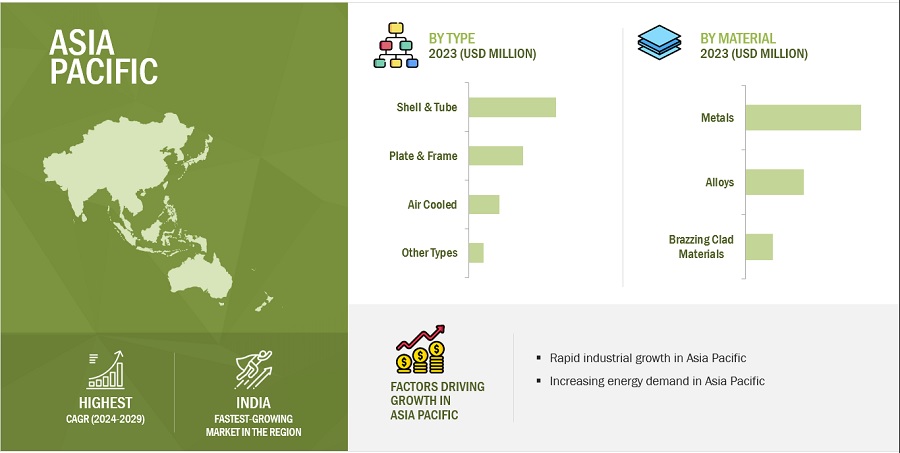
To know about the assumptions considered for the study, download the pdf brochure
Heat Exchanger Market Players
Some of the key players operating in the heat exchanger market include ALFA LAVAL (Sweden), Kelvion Holding GmbH (Germany), Danfoss (Denmark), Exchanger Industries Limited (Canada), Mersen (France), API Heat Transfer (US), Boyd (US), H. Güntner (UK) Limited (Germany), Johnson Controls (Ireland), Xylem (US), Wabtec Corporation (US), SPX FLOW (US), LU-VE S.p.A. (Italy), Lennox International Inc. (US), and Modine Manufacturing Company (US) among others.
These companies have adopted various organic as well as inorganic growth strategies between 2019 and 2023 to strengthen their positions in the market. The new product launch is the key growth strategy adopted by these leading players to enhance regional presence and develop product portfolios to meet the growing demand for heat exchangerfrom emerging economies.
Read More: Heat Exchangers Companies
Heat Exchanger Market Report Scope
|
Report Metric |
Details |
|
Years considered for the study |
2020-2029 |
|
Base Year |
2023 |
|
Forecast period |
2024–2029 |
|
Units considered |
Units; Value (USD Million) |
|
Segments |
Material, Type, End-Use Industry, and Region |
|
Regions |
Asia Pacific, North America, Europe, Middle East & Africa, and South America |
|
Companies |
ALFA LAVAL (Sweden), Kelvion Holding GmbH (Germany), Danfoss (Denmark), Exchanger Industries Limited (Canada), Mersen (France), API Heat Transfer (US), Boyd (US), H. Güntner (UK) Limited (Germany), Johnson Controls (Ireland), Xylem (US), Wabtec Corporation (US), SPX FLOW (US), LU-VE S.p.A. (Italy), Lennox International Inc. (US), and Modine Manufacturing Company (US). |
This report categorizes the global heat exchangers market based on material, type, end-use industry, and region.
Based on the material:
-
Metals
-
Steel
- Carbon Steel
- Stainless Steel
- Copper
- Aluminum
- Titanium
- Nickel
- Other Metals
-
Steel
-
Alloys
-
Nickel Alloys
- Hastelloy
- Inconel
- Monel
- Other Nickel Alloys
- Copper Alloys
- Titanium Alloys
- Other Alloys
-
Nickel Alloys
-
Brazing Clad Materials
- Copper Brazing
- Ni Clad Brazing
- Phosphor Copper Brazing
- Silver Brazing
- Other Brazing Clad Materials
Based on the type:
- Shell & Tube
- Plate & Frame
- Air Cooled
- Other Types
Based on the end-use industry:
- Chemical
- Energy
- HVACR
- Food & Beverage
- Power Generation
- Pulp & Paper
- Other End-Use Industries
Based on the region:
- Asia Pacific
- Europe
- North America
- South America
- Middle East & Africa
Recent Developments
- In December 2023, ALFA LAVAL partnered with Outokumpu, a global steel manufacturer, to reduce carbon emissions by utilizing Outokumpu's Circle Green stainless steel in the production of Alfa Laval's heat exchangers. This partnership targets a decrease in the carbon footprint associated with Alfa Laval's heat exchangers, which typically consist of up to 80 percent stainless steel, by transitioning from conventional stainless steel to a material with a significantly reduced carbon footprint, amounting to half of its original level.
- In November 2023, Danfoss Heat Exchangers signed an agreement with Danfoss Commercial Compressors to establish an in-house test capability for propane located in the ATEX-certified lab in Trevoux in France. The new propane test facility focuses on testing brazed plate heat exchangers ranging from 10 to 150kW capacity.
- In September 2023, Kelvion Holding GmbH has invested USD 4.3 million to expand its production capacities in Sarstedt to meet the increasing demand for its heat exchangers across diverse end-use sectors. This expansion enables the facility to manufacture an extra 150,000 heat exchangers annually, aligning with the company's strategic goal of expanding its presence in the U.S. market and establishing itself as the preferred partner in the Refrigeration and Data Center Industries.
Frequently Asked Questions (FAQ):
What is the current market size of the global heat exchanger market?
Global heat exchanger market size is estimated to reach USD 32.3 billion by 2029 from USD 23.0 billion in 2023, at a CAGR of 7.0% during the forecast period.
Who are the winners in the global heat exchanger market?
Companies such as include ALFA LAVAL (Sweden), Kelvion Holding GmbH (Germany), Danfoss (Denmark), Exchanger Industries Limited (Canada), Mersen (France), API Heat Transfer (US), Boyd (US), H. Güntner (UK) Limited (Germany), Johnson Controls (Ireland), Xylem (US), Wabtec Corporation (US), SPX FLOW (US), LU-VE S.p.A. (Italy), Lennox International Inc. (US), and Modine Manufacturing Company (US) among others. They have the potential to broaden their product portfolio and compete with other key market players.
What are some of the drivers in the market?
Growing demand for heat pumps in Europe, increasing industrialization in emerging economies, rising energy efficiency regulations and stringent emission standards, growing demand for HVACR equipment for commercial construction industry are some drivers of heat exchanger market.
What are the various material of heat exchanger?
Metals, alloys, and brazing clad materials are various materials of heat exchanger.
What are the end-use industries of heat exchanger?
Chemical, Energy, HVAC & Refrigeration, Food & beverage, Power generation, Pulp & paper are the main end-use industries of heat exchanger. .
To speak to our analyst for a discussion on the above findings, click Speak to Analyst
The study involved four major activities in estimating the market size of the heat exchangers market. Exhaustive secondary research was done to collect information on the market, the peer market, and the grandparent market. The next step was to validate these findings, assumptions, and sizing with industry experts across the value chain through primary research. Both top-down and bottom-up approaches were employed to estimate the complete market size. Thereafter, the market breakdown and data triangulation procedures were used to estimate the market size of the segments and subsegments.
Secondary Research
In the secondary research process, various secondary sources have been referred to for identifying and collecting information for this study. These secondary sources include annual reports, press releases, investor presentations of companies, white papers, certified publications, trade directories, articles from recognized authors, gold standard and silver standard websites, and databases. Secondary research has been used to obtain key information about the value chain of the industry, monetary chain of the market, the total pool of key players, market classification and segmentation according to industry trends to the bottom-most level, and regional markets. It was also used to obtain information about the key developments from a market-oriented perspective.
Primary Research
The heat exchangers market comprises several stakeholders in the value chain, which include manufacturers, and end users. Various primary sources from the supply and demand sides of the heat exchangers market have been interviewed to obtain qualitative and quantitative information. The primary interviewees from the demand side include key opinion leaders in HVACR sectors. The primary sources from the supply side include manufacturers, associations, and institutions involved in the heat exchangers industry. Primary interviews were conducted to gather insights such as market statistics, data of revenue collected from the products and services, market breakdowns, market size estimations, market forecasting, and data triangulation. Primary research also helped in understanding the various trends related to material, type, end-use industry, and region. Stakeholders from the demand side, such as CIOs, CTOs, and CSOs were interviewed to understand the buyer’s perspective on the suppliers, products, component providers, and their current usage of heat exchangers and outlook of their business, which will affect the overall market.
The breakdown of profiles of the primary interviewees is illustrated in the figure below:
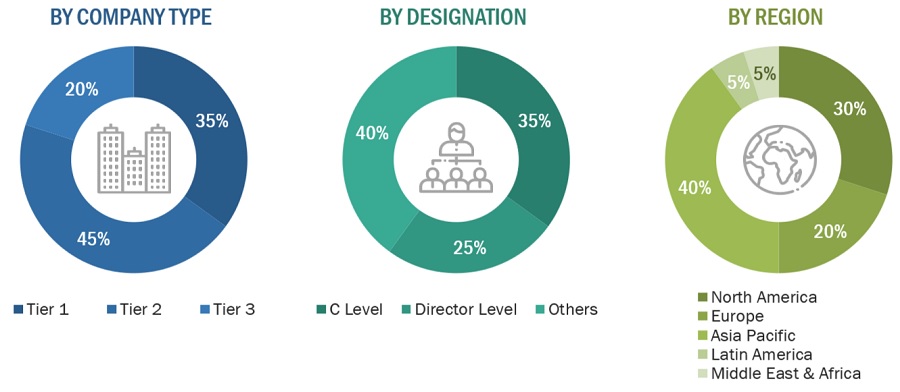
Note: Tier 1, Tier 2, and Tier 3 companies are classified based on their market revenue in 2022 available in the public domain, product portfolios, and geographical presence.
Other designations include consultants and sales, marketing, and procurement managers.
To know about the assumptions considered for the study, download the pdf brochure
Market Size Estimation
The top-down and bottom-up approaches have been used to estimate and validate the size of the heat exchangerss market.
- The key players in the industry have been identified through extensive secondary research.
- The supply chain of the industry has been determined through primary and secondary research.
- All percentage shares, splits, and breakdowns have been determined using secondary sources and verified through primary sources.
- All possible parameters that affect the markets covered in this research study have been accounted for, viewed in extensive detail, verified through primary research, and analyzed to obtain the final quantitative and qualitative data.
- The research includes the study of reports, reviews, and newsletters of the key market players, along with extensive interviews for opinions with leaders such as directors and marketing executives.
Top - Down Approach

To know about the assumptions considered for the study, Request for Free Sample Report
Bottom - Up Approach-

Data Triangulation
After arriving at the total market size from the estimation process, the overall market has been split into several segments and sub-segments. To complete the overall market engineering process and arrive at the exact statistics for all the segments and sub-segments, the data triangulation and market breakdown procedures have been employed, wherever applicable. The data has been triangulated by studying various factors and trends from both the demand and supply sides. Along with this, the market size has been validated by using both the top-down and bottom-up approaches and primary interviews. Hence, for every data segment, there have been three sources—top-down approach, bottom-up approach, and expert interviews. The data was assumed correct when the values arrived from the three sources matched.
Market Definition
Heat exchangers are mechanical devices designed to transfer heat between two or more fluids or between a solid surface and a fluid, without the fluids mixing or coming into direct contact. They facilitate the efficient exchange of thermal energy from one fluid to another, typically to achieve heating, cooling, or temperature control in various industrial, commercial, and residential applications. Heat exchangers come in various types and configurations, including shell-and-tube heat exchangers, plate heat exchangers, finned-tube heat exchangers, spiral heat exchangers, and more. Each type has its own advantages and is chosen based on factors such as the fluid properties, temperature and pressure requirements, space limitations, and efficiency considerations.
Key Stakeholders
- Senior Management
- End User
- Finance/Procurement Department
- R&D Department
- Manufacturers
- Raw Material Suppliers
Report Objectives
- To define, describe, and forecast the size of the heat exchangers market, in terms of value and units.
- To provide detailed information regarding the major factors (drivers, opportunities, restraints, and challenges) influencing the growth of the market
- To estimate and forecast the market size based on material, type, end-use industry, and region.
- To forecast the size of the market with respect to major regions, namely, Europe, North America, Asia Pacific, Middle East & Africa, and South America, along with their key countries
- To strategically analyze micro-markets with respect to individual growth trends, prospects, and their contribution to the overall market
- To analyze opportunities in the market for stakeholders and provide a competitive landscape of market leaders.
- To track and analyze recent developments such as expansions, new product launches, partnerships & agreements, and acquisitions in the market.
- To strategically profile key market players and comprehensively analyze their core competencies.
Available Customizations
Along with the given market data, MarketsandMarkets offers customizations according to the company’s specific needs. The following customization options are available for the report:
Regional Analysis
- Further breakdown of a region with respect to a particular country or additional application
Company Information
- Detailed analysis and profiles of additional market players
Tariff & Regulations
- Regulations and Impact on Heat exchangers Market



 Generating Response ...
Generating Response ...







Growth opportunities and latent adjacency in Heat Exchanger Market